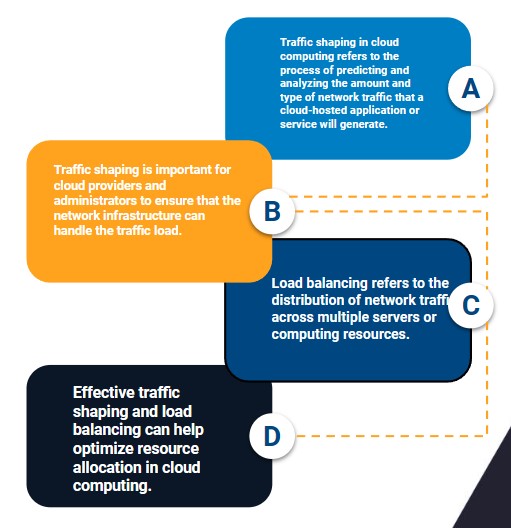Cloud computing is one of the most popular technology solutions used by businesses worldwide to keep their servers, web pages, and other software products safe and accessible. This solution adds traffic shaping and load balancing to its regular features, making it even more full and functional.
When we talk about traffic shaping, we mean "a bandwidth control technique. It is employed in computer networks to delay some or all datagrams. Traffic shaping is designed to conform to a specific traffic profile. Traffic shaping increases latency while increasing throughput. You can also enhance the available bandwidth for specific packet types." According to the Cisco web portal, "the most common type of traffic shaping is application-based traffic shaping."

Is it possible to shape traffic in cloud computing?
In cloud computing, traffic shaping refers to the process of forecasting and evaluating the volume and kind of network traffic generated by a cloud-hosted application or service. This entails employing statistical and analytical tools to model traffic patterns, volume, and user behavior, as well as their interactions with cloud infrastructure.
To ensure that the network infrastructure can manage the predicted traffic load, identify any bottlenecks or performance concerns, and optimize network resources to meet client requirements, cloud providers and administrators must use traffic shaping. User expectations and service level agreements (SLAs).

What exactly is load balancing?
Load balancing is the process of distributing network traffic among multiple servers or computer resources in order to ensure that no device is carrying an excessive amount of load and to improve overall system performance and dependability.
It can be accomplished using a variety of methods, including DNS-based load balancing, hardware or software load balancers, or application-level load balancing. Load balancing's ultimate purpose is to improve the availability, scalability, and efficiency of a server or network infrastructure while minimizing the risk of downtime or service disruption.

Implementation of traffic shaping and load balancing in cloud computing
To improve resource allocation, traffic shaping and load balancing are fundamental concepts in cloud computing. Traffic modeling entails evaluating traffic patterns and user behavior to forecast system demand. This entails gathering information about user activity, such as the number of people who access the system, the amount of data moved, and the frequency of requests.
Load balancing is the process of dividing a workload over multiple servers or resources in order to achieve optimal performance and availability. This can be performed using a variety of approaches, including:
- Load balancing using round-robin: where requests are delivered evenly among servers
- Dynamic load balancing: adjusting resource allocation based on current demand.
Effective traffic shaping and load balancing can assist optimize cloud computing resource allocation by ensuring that resources are used efficiently, reducing the risk of downtime or outages, and enhancing overall cloud performance. This is especially significant in cloud computing, where resources are shared among several users and demand varies frequently.
We recommend you on video

